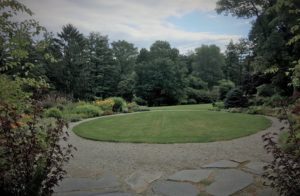Improving Your Lawn? This is the Season
Berkshire Botanical Garden’s beautifully maintained Great Oval and lawn beyond offer a grassy respite for picnickers and popular location for weddings.
By Thomas Christopher
There’s a common misconception among home greenskeepers that spring is the best time of year to sow grass seed. That’s no surprise because spring is when garden and home centers load the shelves with grass seed and “starter fertilizers.”
The fact is, though, that a late summer to early fall sowing is much more likely to be successful in this region of the United States. This time of year brings cooling temperatures and, typically, moderate rains that are ideal for the germination of the types of grasses grown in the Northeast. In addition, whereas the seedlings of a spring sowing soon find themselves subjected to the stress of summer heat and drought, the grass that grows from an early fall sowing has all that season to grow and, after a dormant period in winter, spring too before it must confront its first summer. As a result, the grass from a fall sowing enters summer with deeper roots and more mature top growth and is far better equipped to cope with the inevitable stress.
Sowing new seed now is also one of the easiest ways to rejuvenate a lawn that is thin or weedy. For this, my favorite technique is what is called “overseeding.” This involves working with the existing turf and reinforcing it with the addition of new seed. The best tool for this is an overseeder or slit-seeder, which can be rented by the day for a modest fee from almost any tool rental center. To use this, first cut the existing grass short, to a height of 2 inches or so and remove any clippings – this treatment ensures that the grass seed you sow into the lawn will get the exposure to sunlight it needs to germinate and grow. Then set the overseeder to the proper distribution rate for the type of seed you will be sowing, and then fill the hopper. Overseeders are typically self-propelled, pulling themselves along over the turf to cut parallel shallow grooves in the soil surface into which they sprinkle seeds. Generally it’s best to work in a crisscross pattern, running the overseeder back and forth across the whole lawn one way before turning the machine 90 degrees to cross the lawn back and forth the other; this promotes a more even, complete coverage, and prevents the grass seed from springing up in rows like a cornfield. After the overseeding, make sure the lawn gets a brief moistening with sprinklers in both mornings and evenings until the grass seedlings pop up, at which point you should water more thoroughly but only a couple of times a week during rainless periods.
Overseeding thickens a lawn and fills in blank spots, helping to make the turf resistant to weeds, especially crabgrass, without the use of chemicals. It also enables you to address pest and disease problems by introducing resistant types of grass. For example, I once helped a client whose bluegrass lawn had been the target of chinch bugs by overseeding with a turf-type tall fescue seed that had been inoculated with endophytes. Endophytes are types of fungi that can inhabit certain types of grasses, principally fescues and perennial ryegrasses. The fungi feed on the grasses but in return make them resistant to most turf-eating insects as well as heat stress and some fungal diseases. In the case of my client’s lawn, I overseeded dry, west- and south-facing banks overlooking a swimming pool. The seedlings that emerged provided a thick turf that was untroubled by the chinch bugs the following year.
A Correction: A few weeks ago, in the column, I wrote about invasive earthworms, I passed along a recommendation to kill any “snakeworms” you might find in your garden by dropping them into a bucket of water. A reader has informed me that this doesn’t work. A number of more lethal liquids such as bleach and rubbing alcohol have been recommended. Personally, I think I would stick to the recipe of a friend who says she has used successfully a solution made by adding a couple of big squirts of dish soap to a 16-ounce container of water.
Another alternative is to apply a fertilizer containing tea seed meal such as Early Bird Natural Organic Fertilizer 3-0-1, or Rhizo Aide 1-1-0 Fertilizer, both of which are available from golf course or professional landscape product suppliers. Tea seed meal’s natural saponins, soap-like substances, affect the worms’ mucus coat, controlling the invaders quite effectively.
Thomas Christopher is the co-author of “Garden Revolution” (Timber Press, 2016) and is a volunteer at Berkshire Botanical Garden. berkshirebotanical.org
Be-a-Better-Gardener is a community service of Berkshire Botanical Garden, one of the nation’s oldest botanical gardens in Stockbridge, MA. Its mission to provide knowledge of gardening and the environment through 25 display gardens and a diverse range of classes informs and inspires thousands of students and visitors on horticultural topics every year. Thomas Christopher is the co-author of Garden Revolution (Timber press, 2016) and is a volunteer at Berkshire Botanical Garden. berkshirebotanical.org.




